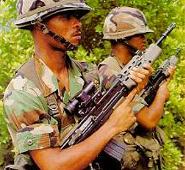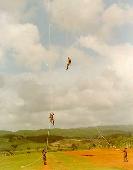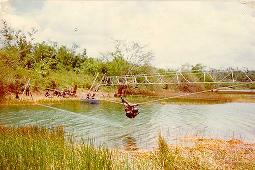|
||
| First Battalion The Jamaica Regiment Second Battalion The Jamaica Regiment History Organisation Roles Operational Duties Peacekeeping Personal Clothing and Equipment Training Exercises Affiliations Reserves General Overview Infantry soldiers are the backbone of all armies. Often referred to as foot soldiers, it is the job of the infantry to close with the enemy and destroy them. All the other elements of armies are organised to support the infantry in achieving this aim. The largest unit of the infantry in the JDF is the battalion. A battalion is a fully independent unit and has all the elements it needs to sustain itself in battle. Training for the infantryman is varied and comprehensive. Every infantryman is trained in weaponry and marksmanship, fieldcraft, tactics, map reading and navigation, communications, first aid, survival techniques, physical fitness, etc. To become a fully trained infantryman takes dedication, intelligence and a will to succeed. To accomplish the mission not only must the infantryman be well trained but must also be well equipped. The current personal weapon of the infantryman is the Self-Loading Rifle (SLR). This weapon has proven itself to be a reliable and effective weapon and is popular with its users. Other weapons used by the infantry are the 7.62mm General Purpose Weapon Machine Gun (GPMG) at section and platoon level; the Heavy Barrel Automatic (HBA), 5.56mm Individual Weapon (WI) (SA80), the Sterling Submachine Gun (SMG) 9mm, Grenade Launcher (M79), the 51mm mortar, and the 81mm Mortar at battalion level.
There are two regular infantry battalions in the Jamaica
Defence Force. The earlier, the First Battalion the
Jamaica Regiment (1JR), was raised on 31 July 1962 simultaneously with a
reserve unit, the Third Battalion The Jamaica
Regiment (National Reserve) The infantry units are non-mechanised infantry battalions. The regular battalions comprise three rifle companies and a headquarter company which sees to the first line administrative needs of the battalion. It is noteworthy that the Jamaica Regiment Band is on the
strength of 1 JR but serves both regular infantry battalions. The band is permanently
stationed in Kingston and is administered by the headquarter company of the Kingston-based
battalion. The units’ primary role is the development of professionals in the art of war and the conduct of land battles, while being prepared for all aspects of combat operations. In addition, the units provide troops in support of the overall roles of the Jamaica Defence Force, namely:
The operational commitments of the units vary with their location. The units are rotated annually, stationed either at Up Park Camp or Moneague Training Camp. The Kingston-based unit is committed to assisting the civil police in maintaining law and order. The battalion at Moneague is tasked with two operations, marijuana eradication and assisting the civil police in maintaining law and order in some rural areas.
The infantry units have been involved in three peacekeeping missions overseas: Operation URGENT FURY – Grenada, 1983-85; Operation CARIB – Trinidad, 1990; and the most recent deployment, Operation ANVIL – Haiti, 1994-96, where for the first time the JDF was a part of a United Nations peacekeeping force.
Personal
Clothing and Equipment The Jamaican soldier can expect to operate in the extremes, from jungle type conditions to urban areas. The 58 pattern system is based on the layer principle and is designed to provide the soldier with exactly the right degree of protection for the environment he is operating in. The 58 pattern system includes:
The infantry units are affiliated with two allied regiments;
in the UK – The Staffordshire Regiment (The
Prince of Wales’s) and in Canada – the Royal Canadian Regiment. |



 Moneague
Training Camp is the units’ primary training facility and during the year troops spend
there, they undergo intensive training in conventional warfare and internal security
operations. A number of training courses and cadres are also conducted there. Members of
both battalions also attend courses at Jamaican and overseas institutions.
Moneague
Training Camp is the units’ primary training facility and during the year troops spend
there, they undergo intensive training in conventional warfare and internal security
operations. A number of training courses and cadres are also conducted there. Members of
both battalions also attend courses at Jamaican and overseas institutions. The
units participate, usually annually, in the following exercises held in the Caribbean:
Exercises TRADEWINDS, OCEAN VENTURE, DUTCH COMMANDO and FRENCH COMMANDO;
these emphasize infantry and commando skills training. The units also participate in
overseas exercises such as Exercise RED STRIPE/CALYPSO HOP with the British Army
and Exercise NORTHERN/SOUTHERN ROYAL with the Royal Canadian Regiment.
The
units participate, usually annually, in the following exercises held in the Caribbean:
Exercises TRADEWINDS, OCEAN VENTURE, DUTCH COMMANDO and FRENCH COMMANDO;
these emphasize infantry and commando skills training. The units also participate in
overseas exercises such as Exercise RED STRIPE/CALYPSO HOP with the British Army
and Exercise NORTHERN/SOUTHERN ROYAL with the Royal Canadian Regiment.